Analysis of Legal and Ethical Principles in Healthcare: Case Study
VerifiedAdded on 2022/09/26
|11
|3127
|193
Report
AI Summary
This report provides a comprehensive analysis of legal and ethical principles within the healthcare context, specifically examining a case study involving a patient named Doreen Richmond. The report delves into various ethical and legal issues, including advance health directives, patient autonomy, informed consent, and the roles of different stakeholders in decision-making. It explores the complexities of applying ethical principles in nursing practice, such as respecting patient wishes while adhering to legal requirements. The analysis covers scenarios involving tracheotomies, pacemaker insertions, and "Not for CPR" orders, considering the perspectives of healthcare professionals, friends, and legal guardians. The report also highlights the importance of understanding Queensland law in healthcare decision-making and emphasizes the need for healthcare professionals to balance patient rights with ethical considerations, ultimately aiming to improve critical thinking and decision-making in patient care.
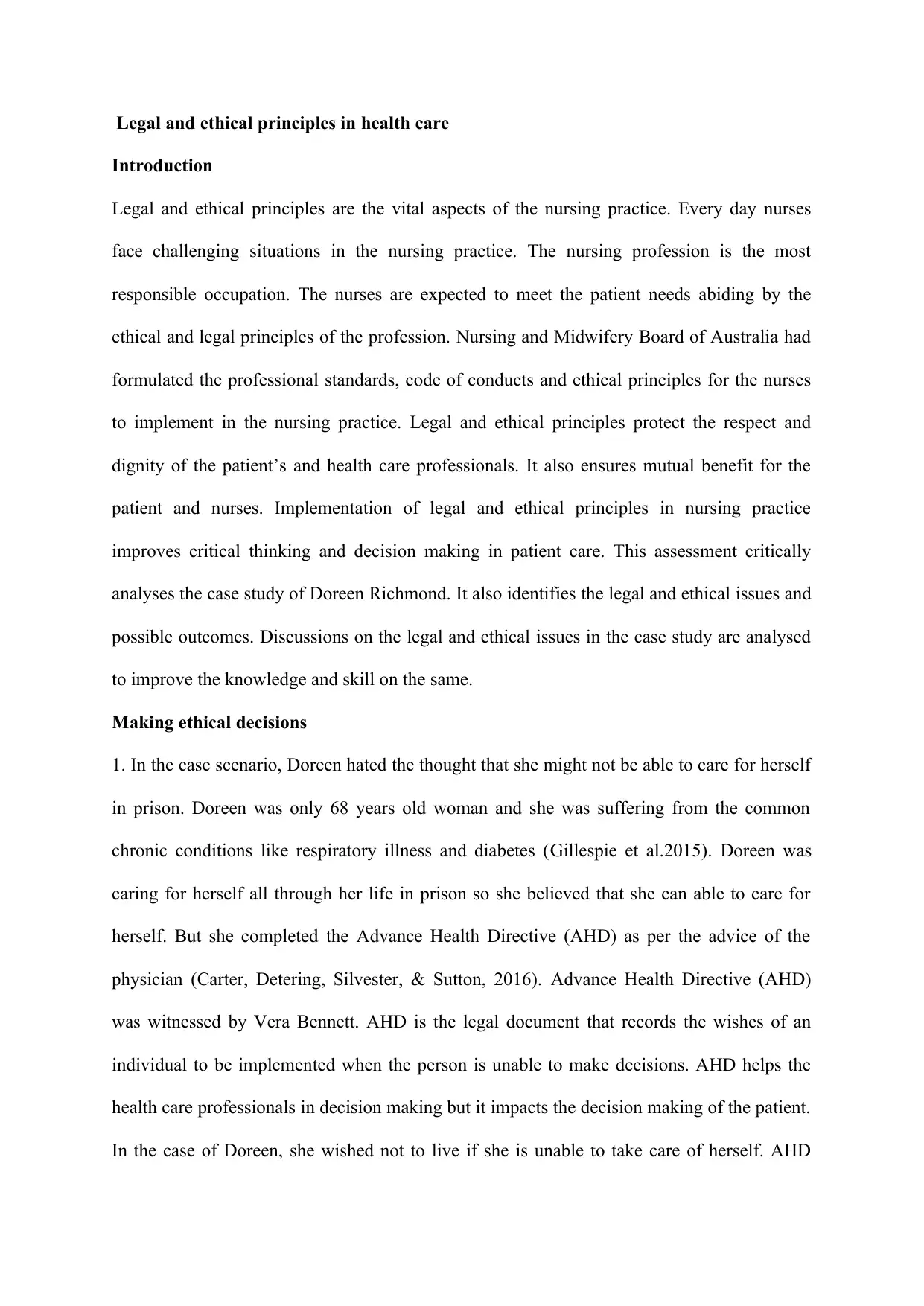
Legal and ethical principles in health care
Introduction
Legal and ethical principles are the vital aspects of the nursing practice. Every day nurses
face challenging situations in the nursing practice. The nursing profession is the most
responsible occupation. The nurses are expected to meet the patient needs abiding by the
ethical and legal principles of the profession. Nursing and Midwifery Board of Australia had
formulated the professional standards, code of conducts and ethical principles for the nurses
to implement in the nursing practice. Legal and ethical principles protect the respect and
dignity of the patient’s and health care professionals. It also ensures mutual benefit for the
patient and nurses. Implementation of legal and ethical principles in nursing practice
improves critical thinking and decision making in patient care. This assessment critically
analyses the case study of Doreen Richmond. It also identifies the legal and ethical issues and
possible outcomes. Discussions on the legal and ethical issues in the case study are analysed
to improve the knowledge and skill on the same.
Making ethical decisions
1. In the case scenario, Doreen hated the thought that she might not be able to care for herself
in prison. Doreen was only 68 years old woman and she was suffering from the common
chronic conditions like respiratory illness and diabetes (Gillespie et al.2015). Doreen was
caring for herself all through her life in prison so she believed that she can able to care for
herself. But she completed the Advance Health Directive (AHD) as per the advice of the
physician (Carter, Detering, Silvester, & Sutton, 2016). Advance Health Directive (AHD)
was witnessed by Vera Bennett. AHD is the legal document that records the wishes of an
individual to be implemented when the person is unable to make decisions. AHD helps the
health care professionals in decision making but it impacts the decision making of the patient.
In the case of Doreen, she wished not to live if she is unable to take care of herself. AHD
Introduction
Legal and ethical principles are the vital aspects of the nursing practice. Every day nurses
face challenging situations in the nursing practice. The nursing profession is the most
responsible occupation. The nurses are expected to meet the patient needs abiding by the
ethical and legal principles of the profession. Nursing and Midwifery Board of Australia had
formulated the professional standards, code of conducts and ethical principles for the nurses
to implement in the nursing practice. Legal and ethical principles protect the respect and
dignity of the patient’s and health care professionals. It also ensures mutual benefit for the
patient and nurses. Implementation of legal and ethical principles in nursing practice
improves critical thinking and decision making in patient care. This assessment critically
analyses the case study of Doreen Richmond. It also identifies the legal and ethical issues and
possible outcomes. Discussions on the legal and ethical issues in the case study are analysed
to improve the knowledge and skill on the same.
Making ethical decisions
1. In the case scenario, Doreen hated the thought that she might not be able to care for herself
in prison. Doreen was only 68 years old woman and she was suffering from the common
chronic conditions like respiratory illness and diabetes (Gillespie et al.2015). Doreen was
caring for herself all through her life in prison so she believed that she can able to care for
herself. But she completed the Advance Health Directive (AHD) as per the advice of the
physician (Carter, Detering, Silvester, & Sutton, 2016). Advance Health Directive (AHD)
was witnessed by Vera Bennett. AHD is the legal document that records the wishes of an
individual to be implemented when the person is unable to make decisions. AHD helps the
health care professionals in decision making but it impacts the decision making of the patient.
In the case of Doreen, she wished not to live if she is unable to take care of herself. AHD
Paraphrase This Document
Need a fresh take? Get an instant paraphrase of this document with our AI Paraphraser
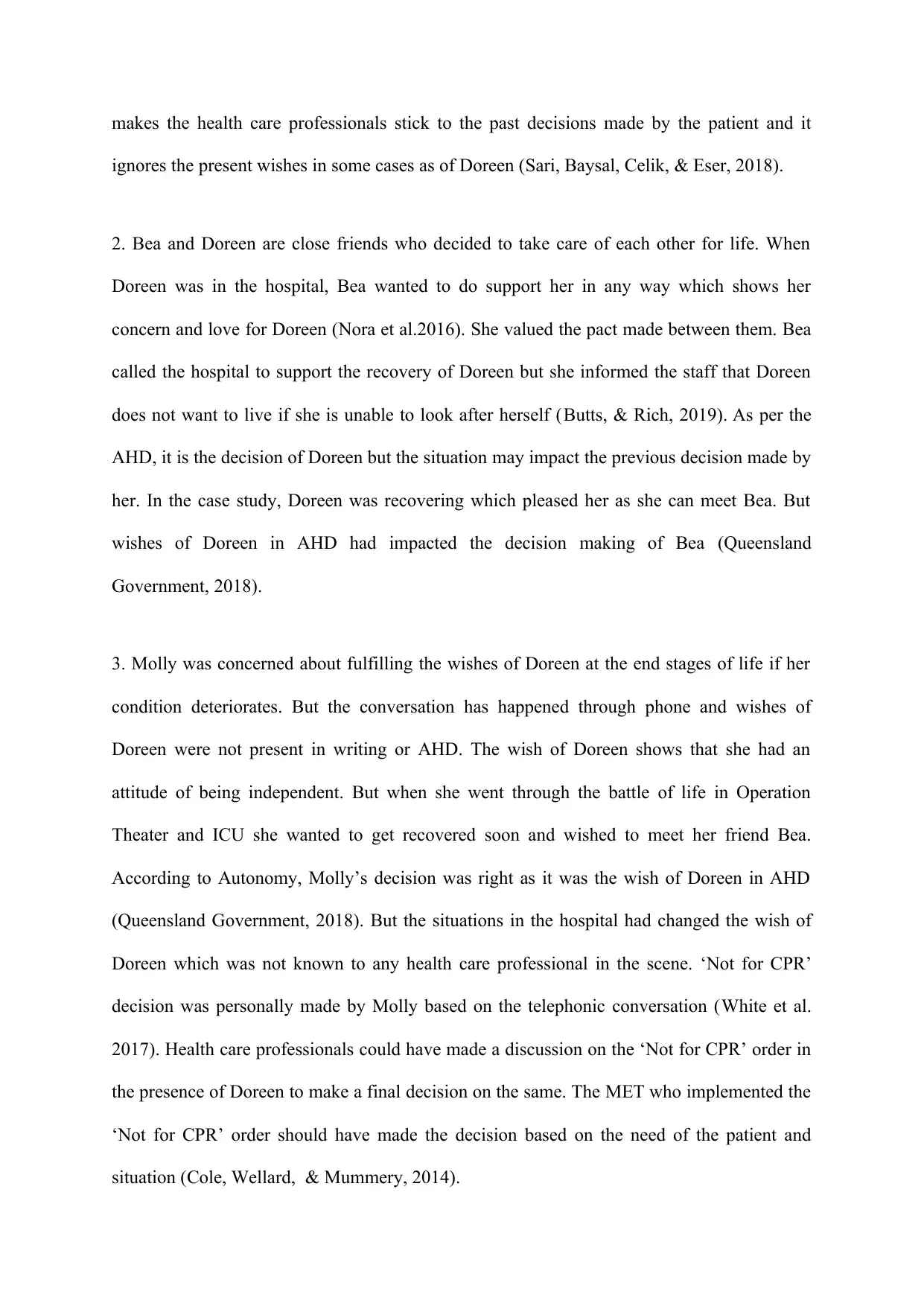
makes the health care professionals stick to the past decisions made by the patient and it
ignores the present wishes in some cases as of Doreen (Sari, Baysal, Celik, & Eser, 2018).
2. Bea and Doreen are close friends who decided to take care of each other for life. When
Doreen was in the hospital, Bea wanted to do support her in any way which shows her
concern and love for Doreen (Nora et al.2016). She valued the pact made between them. Bea
called the hospital to support the recovery of Doreen but she informed the staff that Doreen
does not want to live if she is unable to look after herself (Butts, & Rich, 2019). As per the
AHD, it is the decision of Doreen but the situation may impact the previous decision made by
her. In the case study, Doreen was recovering which pleased her as she can meet Bea. But
wishes of Doreen in AHD had impacted the decision making of Bea (Queensland
Government, 2018).
3. Molly was concerned about fulfilling the wishes of Doreen at the end stages of life if her
condition deteriorates. But the conversation has happened through phone and wishes of
Doreen were not present in writing or AHD. The wish of Doreen shows that she had an
attitude of being independent. But when she went through the battle of life in Operation
Theater and ICU she wanted to get recovered soon and wished to meet her friend Bea.
According to Autonomy, Molly’s decision was right as it was the wish of Doreen in AHD
(Queensland Government, 2018). But the situations in the hospital had changed the wish of
Doreen which was not known to any health care professional in the scene. ‘Not for CPR’
decision was personally made by Molly based on the telephonic conversation (White et al.
2017). Health care professionals could have made a discussion on the ‘Not for CPR’ order in
the presence of Doreen to make a final decision on the same. The MET who implemented the
‘Not for CPR’ order should have made the decision based on the need of the patient and
situation (Cole, Wellard, & Mummery, 2014).
ignores the present wishes in some cases as of Doreen (Sari, Baysal, Celik, & Eser, 2018).
2. Bea and Doreen are close friends who decided to take care of each other for life. When
Doreen was in the hospital, Bea wanted to do support her in any way which shows her
concern and love for Doreen (Nora et al.2016). She valued the pact made between them. Bea
called the hospital to support the recovery of Doreen but she informed the staff that Doreen
does not want to live if she is unable to look after herself (Butts, & Rich, 2019). As per the
AHD, it is the decision of Doreen but the situation may impact the previous decision made by
her. In the case study, Doreen was recovering which pleased her as she can meet Bea. But
wishes of Doreen in AHD had impacted the decision making of Bea (Queensland
Government, 2018).
3. Molly was concerned about fulfilling the wishes of Doreen at the end stages of life if her
condition deteriorates. But the conversation has happened through phone and wishes of
Doreen were not present in writing or AHD. The wish of Doreen shows that she had an
attitude of being independent. But when she went through the battle of life in Operation
Theater and ICU she wanted to get recovered soon and wished to meet her friend Bea.
According to Autonomy, Molly’s decision was right as it was the wish of Doreen in AHD
(Queensland Government, 2018). But the situations in the hospital had changed the wish of
Doreen which was not known to any health care professional in the scene. ‘Not for CPR’
decision was personally made by Molly based on the telephonic conversation (White et al.
2017). Health care professionals could have made a discussion on the ‘Not for CPR’ order in
the presence of Doreen to make a final decision on the same. The MET who implemented the
‘Not for CPR’ order should have made the decision based on the need of the patient and
situation (Cole, Wellard, & Mummery, 2014).
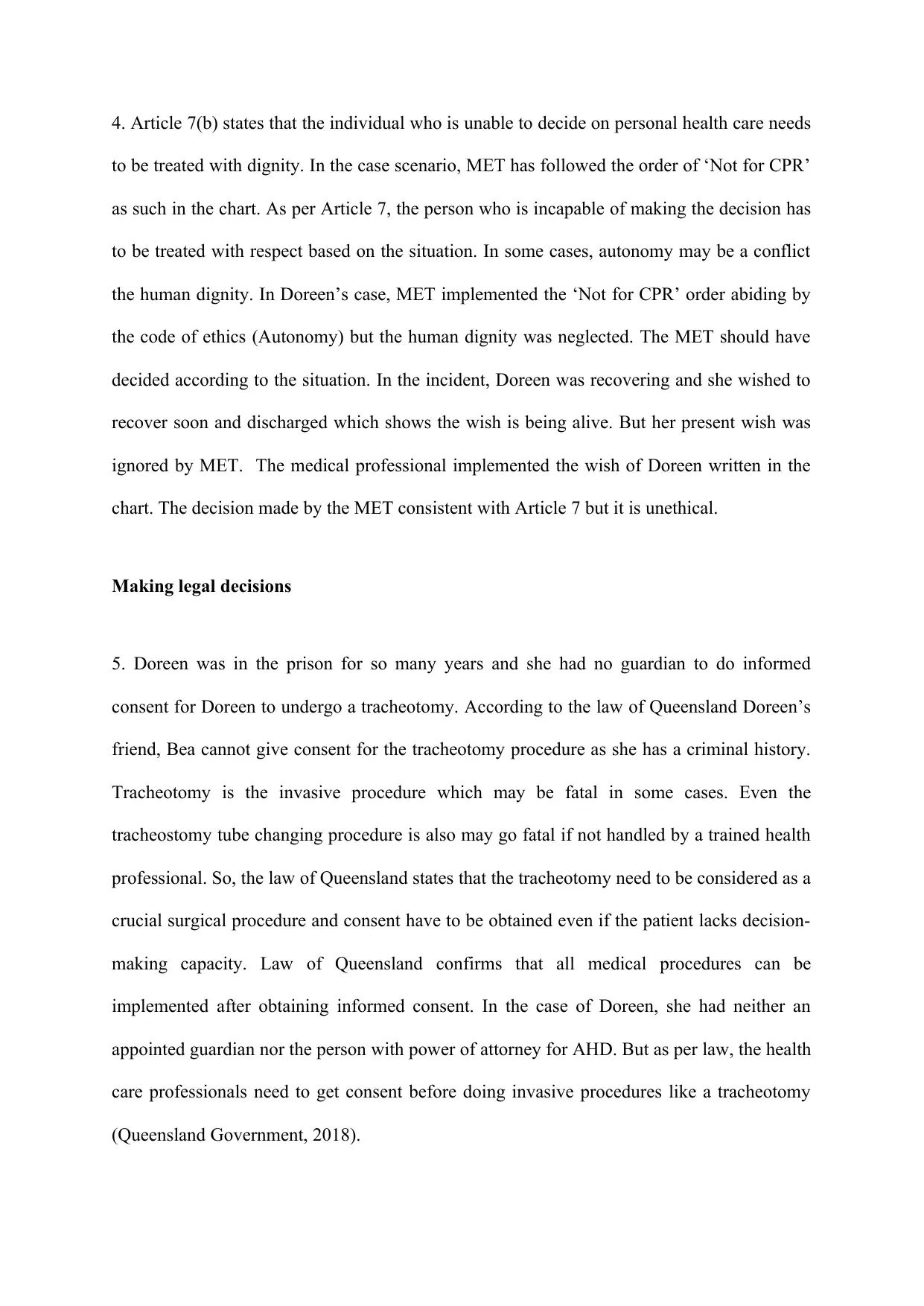
4. Article 7(b) states that the individual who is unable to decide on personal health care needs
to be treated with dignity. In the case scenario, MET has followed the order of ‘Not for CPR’
as such in the chart. As per Article 7, the person who is incapable of making the decision has
to be treated with respect based on the situation. In some cases, autonomy may be a conflict
the human dignity. In Doreen’s case, MET implemented the ‘Not for CPR’ order abiding by
the code of ethics (Autonomy) but the human dignity was neglected. The MET should have
decided according to the situation. In the incident, Doreen was recovering and she wished to
recover soon and discharged which shows the wish is being alive. But her present wish was
ignored by MET. The medical professional implemented the wish of Doreen written in the
chart. The decision made by the MET consistent with Article 7 but it is unethical.
Making legal decisions
5. Doreen was in the prison for so many years and she had no guardian to do informed
consent for Doreen to undergo a tracheotomy. According to the law of Queensland Doreen’s
friend, Bea cannot give consent for the tracheotomy procedure as she has a criminal history.
Tracheotomy is the invasive procedure which may be fatal in some cases. Even the
tracheostomy tube changing procedure is also may go fatal if not handled by a trained health
professional. So, the law of Queensland states that the tracheotomy need to be considered as a
crucial surgical procedure and consent have to be obtained even if the patient lacks decision-
making capacity. Law of Queensland confirms that all medical procedures can be
implemented after obtaining informed consent. In the case of Doreen, she had neither an
appointed guardian nor the person with power of attorney for AHD. But as per law, the health
care professionals need to get consent before doing invasive procedures like a tracheotomy
(Queensland Government, 2018).
to be treated with dignity. In the case scenario, MET has followed the order of ‘Not for CPR’
as such in the chart. As per Article 7, the person who is incapable of making the decision has
to be treated with respect based on the situation. In some cases, autonomy may be a conflict
the human dignity. In Doreen’s case, MET implemented the ‘Not for CPR’ order abiding by
the code of ethics (Autonomy) but the human dignity was neglected. The MET should have
decided according to the situation. In the incident, Doreen was recovering and she wished to
recover soon and discharged which shows the wish is being alive. But her present wish was
ignored by MET. The medical professional implemented the wish of Doreen written in the
chart. The decision made by the MET consistent with Article 7 but it is unethical.
Making legal decisions
5. Doreen was in the prison for so many years and she had no guardian to do informed
consent for Doreen to undergo a tracheotomy. According to the law of Queensland Doreen’s
friend, Bea cannot give consent for the tracheotomy procedure as she has a criminal history.
Tracheotomy is the invasive procedure which may be fatal in some cases. Even the
tracheostomy tube changing procedure is also may go fatal if not handled by a trained health
professional. So, the law of Queensland states that the tracheotomy need to be considered as a
crucial surgical procedure and consent have to be obtained even if the patient lacks decision-
making capacity. Law of Queensland confirms that all medical procedures can be
implemented after obtaining informed consent. In the case of Doreen, she had neither an
appointed guardian nor the person with power of attorney for AHD. But as per law, the health
care professionals need to get consent before doing invasive procedures like a tracheotomy
(Queensland Government, 2018).
⊘ This is a preview!⊘
Do you want full access?
Subscribe today to unlock all pages.

Trusted by 1+ million students worldwide
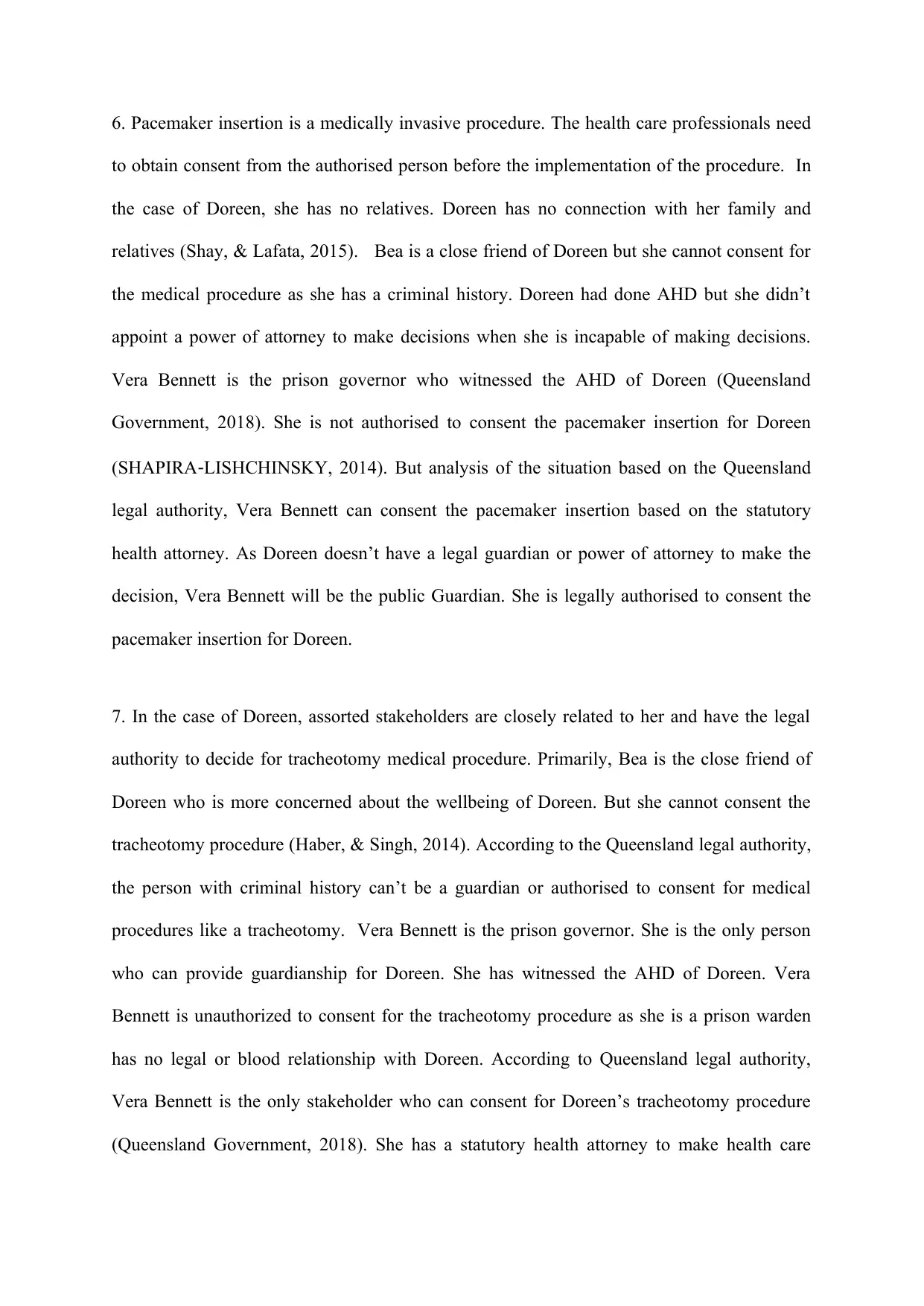
6. Pacemaker insertion is a medically invasive procedure. The health care professionals need
to obtain consent from the authorised person before the implementation of the procedure. In
the case of Doreen, she has no relatives. Doreen has no connection with her family and
relatives (Shay, & Lafata, 2015). Bea is a close friend of Doreen but she cannot consent for
the medical procedure as she has a criminal history. Doreen had done AHD but she didn’t
appoint a power of attorney to make decisions when she is incapable of making decisions.
Vera Bennett is the prison governor who witnessed the AHD of Doreen (Queensland
Government, 2018). She is not authorised to consent the pacemaker insertion for Doreen
(SHAPIRA‐LISHCHINSKY, 2014). But analysis of the situation based on the Queensland
legal authority, Vera Bennett can consent the pacemaker insertion based on the statutory
health attorney. As Doreen doesn’t have a legal guardian or power of attorney to make the
decision, Vera Bennett will be the public Guardian. She is legally authorised to consent the
pacemaker insertion for Doreen.
7. In the case of Doreen, assorted stakeholders are closely related to her and have the legal
authority to decide for tracheotomy medical procedure. Primarily, Bea is the close friend of
Doreen who is more concerned about the wellbeing of Doreen. But she cannot consent the
tracheotomy procedure (Haber, & Singh, 2014). According to the Queensland legal authority,
the person with criminal history can’t be a guardian or authorised to consent for medical
procedures like a tracheotomy. Vera Bennett is the prison governor. She is the only person
who can provide guardianship for Doreen. She has witnessed the AHD of Doreen. Vera
Bennett is unauthorized to consent for the tracheotomy procedure as she is a prison warden
has no legal or blood relationship with Doreen. According to Queensland legal authority,
Vera Bennett is the only stakeholder who can consent for Doreen’s tracheotomy procedure
(Queensland Government, 2018). She has a statutory health attorney to make health care
to obtain consent from the authorised person before the implementation of the procedure. In
the case of Doreen, she has no relatives. Doreen has no connection with her family and
relatives (Shay, & Lafata, 2015). Bea is a close friend of Doreen but she cannot consent for
the medical procedure as she has a criminal history. Doreen had done AHD but she didn’t
appoint a power of attorney to make decisions when she is incapable of making decisions.
Vera Bennett is the prison governor who witnessed the AHD of Doreen (Queensland
Government, 2018). She is not authorised to consent the pacemaker insertion for Doreen
(SHAPIRA‐LISHCHINSKY, 2014). But analysis of the situation based on the Queensland
legal authority, Vera Bennett can consent the pacemaker insertion based on the statutory
health attorney. As Doreen doesn’t have a legal guardian or power of attorney to make the
decision, Vera Bennett will be the public Guardian. She is legally authorised to consent the
pacemaker insertion for Doreen.
7. In the case of Doreen, assorted stakeholders are closely related to her and have the legal
authority to decide for tracheotomy medical procedure. Primarily, Bea is the close friend of
Doreen who is more concerned about the wellbeing of Doreen. But she cannot consent the
tracheotomy procedure (Haber, & Singh, 2014). According to the Queensland legal authority,
the person with criminal history can’t be a guardian or authorised to consent for medical
procedures like a tracheotomy. Vera Bennett is the prison governor. She is the only person
who can provide guardianship for Doreen. She has witnessed the AHD of Doreen. Vera
Bennett is unauthorized to consent for the tracheotomy procedure as she is a prison warden
has no legal or blood relationship with Doreen. According to Queensland legal authority,
Vera Bennett is the only stakeholder who can consent for Doreen’s tracheotomy procedure
(Queensland Government, 2018). She has a statutory health attorney to make health care
Paraphrase This Document
Need a fresh take? Get an instant paraphrase of this document with our AI Paraphraser
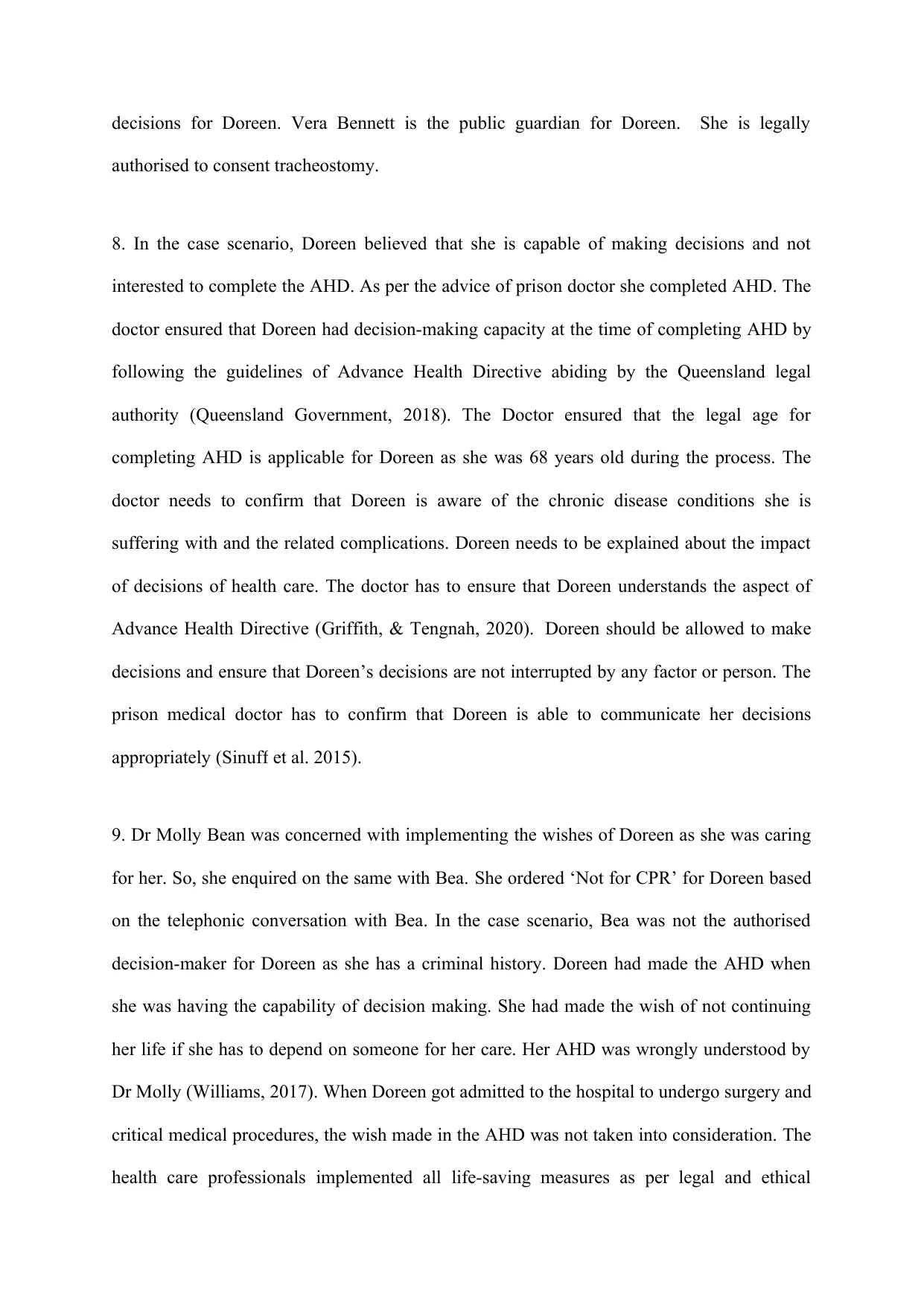
decisions for Doreen. Vera Bennett is the public guardian for Doreen. She is legally
authorised to consent tracheostomy.
8. In the case scenario, Doreen believed that she is capable of making decisions and not
interested to complete the AHD. As per the advice of prison doctor she completed AHD. The
doctor ensured that Doreen had decision-making capacity at the time of completing AHD by
following the guidelines of Advance Health Directive abiding by the Queensland legal
authority (Queensland Government, 2018). The Doctor ensured that the legal age for
completing AHD is applicable for Doreen as she was 68 years old during the process. The
doctor needs to confirm that Doreen is aware of the chronic disease conditions she is
suffering with and the related complications. Doreen needs to be explained about the impact
of decisions of health care. The doctor has to ensure that Doreen understands the aspect of
Advance Health Directive (Griffith, & Tengnah, 2020). Doreen should be allowed to make
decisions and ensure that Doreen’s decisions are not interrupted by any factor or person. The
prison medical doctor has to confirm that Doreen is able to communicate her decisions
appropriately (Sinuff et al. 2015).
9. Dr Molly Bean was concerned with implementing the wishes of Doreen as she was caring
for her. So, she enquired on the same with Bea. She ordered ‘Not for CPR’ for Doreen based
on the telephonic conversation with Bea. In the case scenario, Bea was not the authorised
decision-maker for Doreen as she has a criminal history. Doreen had made the AHD when
she was having the capability of decision making. She had made the wish of not continuing
her life if she has to depend on someone for her care. Her AHD was wrongly understood by
Dr Molly (Williams, 2017). When Doreen got admitted to the hospital to undergo surgery and
critical medical procedures, the wish made in the AHD was not taken into consideration. The
health care professionals implemented all life-saving measures as per legal and ethical
authorised to consent tracheostomy.
8. In the case scenario, Doreen believed that she is capable of making decisions and not
interested to complete the AHD. As per the advice of prison doctor she completed AHD. The
doctor ensured that Doreen had decision-making capacity at the time of completing AHD by
following the guidelines of Advance Health Directive abiding by the Queensland legal
authority (Queensland Government, 2018). The Doctor ensured that the legal age for
completing AHD is applicable for Doreen as she was 68 years old during the process. The
doctor needs to confirm that Doreen is aware of the chronic disease conditions she is
suffering with and the related complications. Doreen needs to be explained about the impact
of decisions of health care. The doctor has to ensure that Doreen understands the aspect of
Advance Health Directive (Griffith, & Tengnah, 2020). Doreen should be allowed to make
decisions and ensure that Doreen’s decisions are not interrupted by any factor or person. The
prison medical doctor has to confirm that Doreen is able to communicate her decisions
appropriately (Sinuff et al. 2015).
9. Dr Molly Bean was concerned with implementing the wishes of Doreen as she was caring
for her. So, she enquired on the same with Bea. She ordered ‘Not for CPR’ for Doreen based
on the telephonic conversation with Bea. In the case scenario, Bea was not the authorised
decision-maker for Doreen as she has a criminal history. Doreen had made the AHD when
she was having the capability of decision making. She had made the wish of not continuing
her life if she has to depend on someone for her care. Her AHD was wrongly understood by
Dr Molly (Williams, 2017). When Doreen got admitted to the hospital to undergo surgery and
critical medical procedures, the wish made in the AHD was not taken into consideration. The
health care professionals implemented all life-saving measures as per legal and ethical
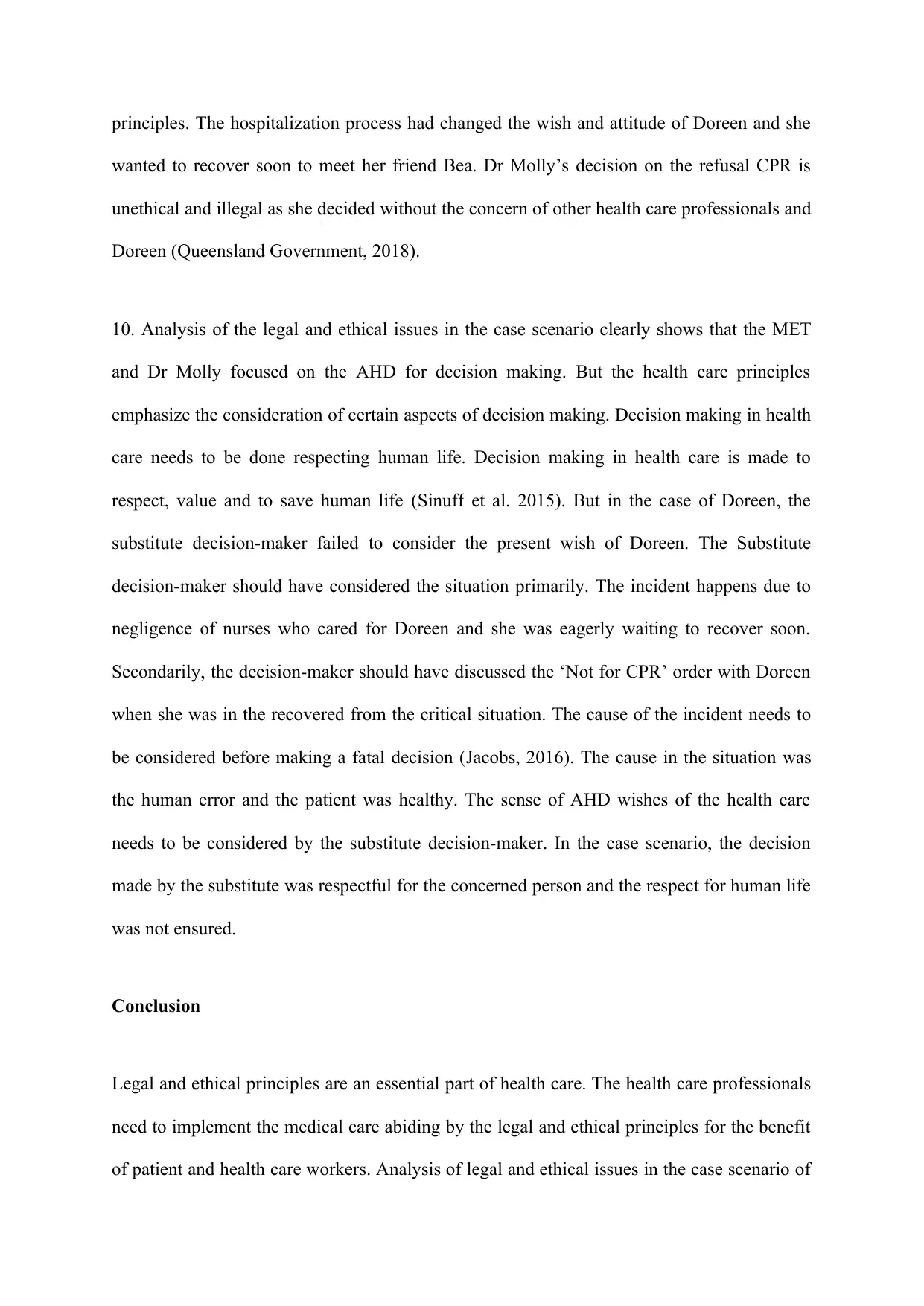
principles. The hospitalization process had changed the wish and attitude of Doreen and she
wanted to recover soon to meet her friend Bea. Dr Molly’s decision on the refusal CPR is
unethical and illegal as she decided without the concern of other health care professionals and
Doreen (Queensland Government, 2018).
10. Analysis of the legal and ethical issues in the case scenario clearly shows that the MET
and Dr Molly focused on the AHD for decision making. But the health care principles
emphasize the consideration of certain aspects of decision making. Decision making in health
care needs to be done respecting human life. Decision making in health care is made to
respect, value and to save human life (Sinuff et al. 2015). But in the case of Doreen, the
substitute decision-maker failed to consider the present wish of Doreen. The Substitute
decision-maker should have considered the situation primarily. The incident happens due to
negligence of nurses who cared for Doreen and she was eagerly waiting to recover soon.
Secondarily, the decision-maker should have discussed the ‘Not for CPR’ order with Doreen
when she was in the recovered from the critical situation. The cause of the incident needs to
be considered before making a fatal decision (Jacobs, 2016). The cause in the situation was
the human error and the patient was healthy. The sense of AHD wishes of the health care
needs to be considered by the substitute decision-maker. In the case scenario, the decision
made by the substitute was respectful for the concerned person and the respect for human life
was not ensured.
Conclusion
Legal and ethical principles are an essential part of health care. The health care professionals
need to implement the medical care abiding by the legal and ethical principles for the benefit
of patient and health care workers. Analysis of legal and ethical issues in the case scenario of
wanted to recover soon to meet her friend Bea. Dr Molly’s decision on the refusal CPR is
unethical and illegal as she decided without the concern of other health care professionals and
Doreen (Queensland Government, 2018).
10. Analysis of the legal and ethical issues in the case scenario clearly shows that the MET
and Dr Molly focused on the AHD for decision making. But the health care principles
emphasize the consideration of certain aspects of decision making. Decision making in health
care needs to be done respecting human life. Decision making in health care is made to
respect, value and to save human life (Sinuff et al. 2015). But in the case of Doreen, the
substitute decision-maker failed to consider the present wish of Doreen. The Substitute
decision-maker should have considered the situation primarily. The incident happens due to
negligence of nurses who cared for Doreen and she was eagerly waiting to recover soon.
Secondarily, the decision-maker should have discussed the ‘Not for CPR’ order with Doreen
when she was in the recovered from the critical situation. The cause of the incident needs to
be considered before making a fatal decision (Jacobs, 2016). The cause in the situation was
the human error and the patient was healthy. The sense of AHD wishes of the health care
needs to be considered by the substitute decision-maker. In the case scenario, the decision
made by the substitute was respectful for the concerned person and the respect for human life
was not ensured.
Conclusion
Legal and ethical principles are an essential part of health care. The health care professionals
need to implement the medical care abiding by the legal and ethical principles for the benefit
of patient and health care workers. Analysis of legal and ethical issues in the case scenario of
⊘ This is a preview!⊘
Do you want full access?
Subscribe today to unlock all pages.

Trusted by 1+ million students worldwide
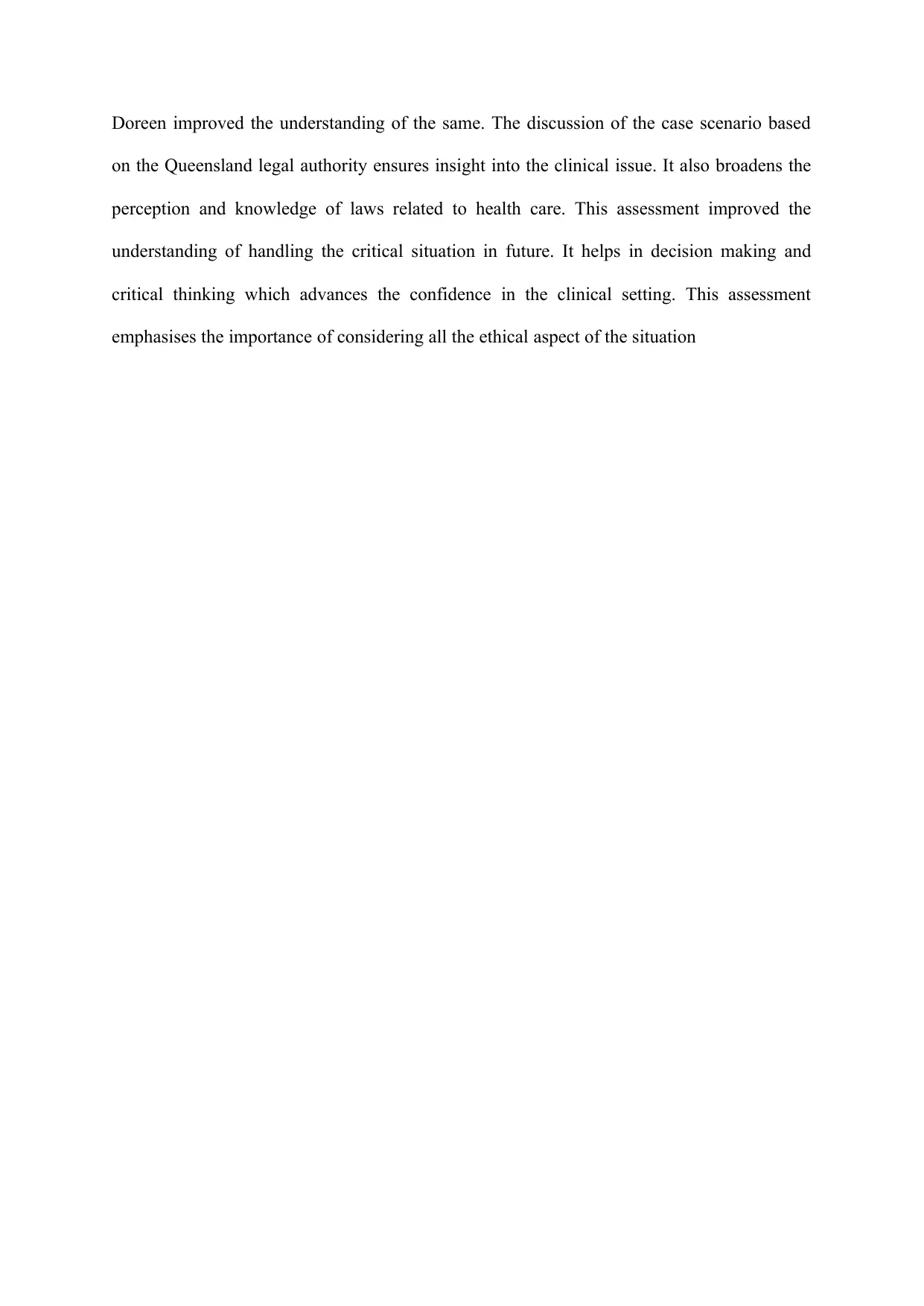
Doreen improved the understanding of the same. The discussion of the case scenario based
on the Queensland legal authority ensures insight into the clinical issue. It also broadens the
perception and knowledge of laws related to health care. This assessment improved the
understanding of handling the critical situation in future. It helps in decision making and
critical thinking which advances the confidence in the clinical setting. This assessment
emphasises the importance of considering all the ethical aspect of the situation
on the Queensland legal authority ensures insight into the clinical issue. It also broadens the
perception and knowledge of laws related to health care. This assessment improved the
understanding of handling the critical situation in future. It helps in decision making and
critical thinking which advances the confidence in the clinical setting. This assessment
emphasises the importance of considering all the ethical aspect of the situation
Paraphrase This Document
Need a fresh take? Get an instant paraphrase of this document with our AI Paraphraser
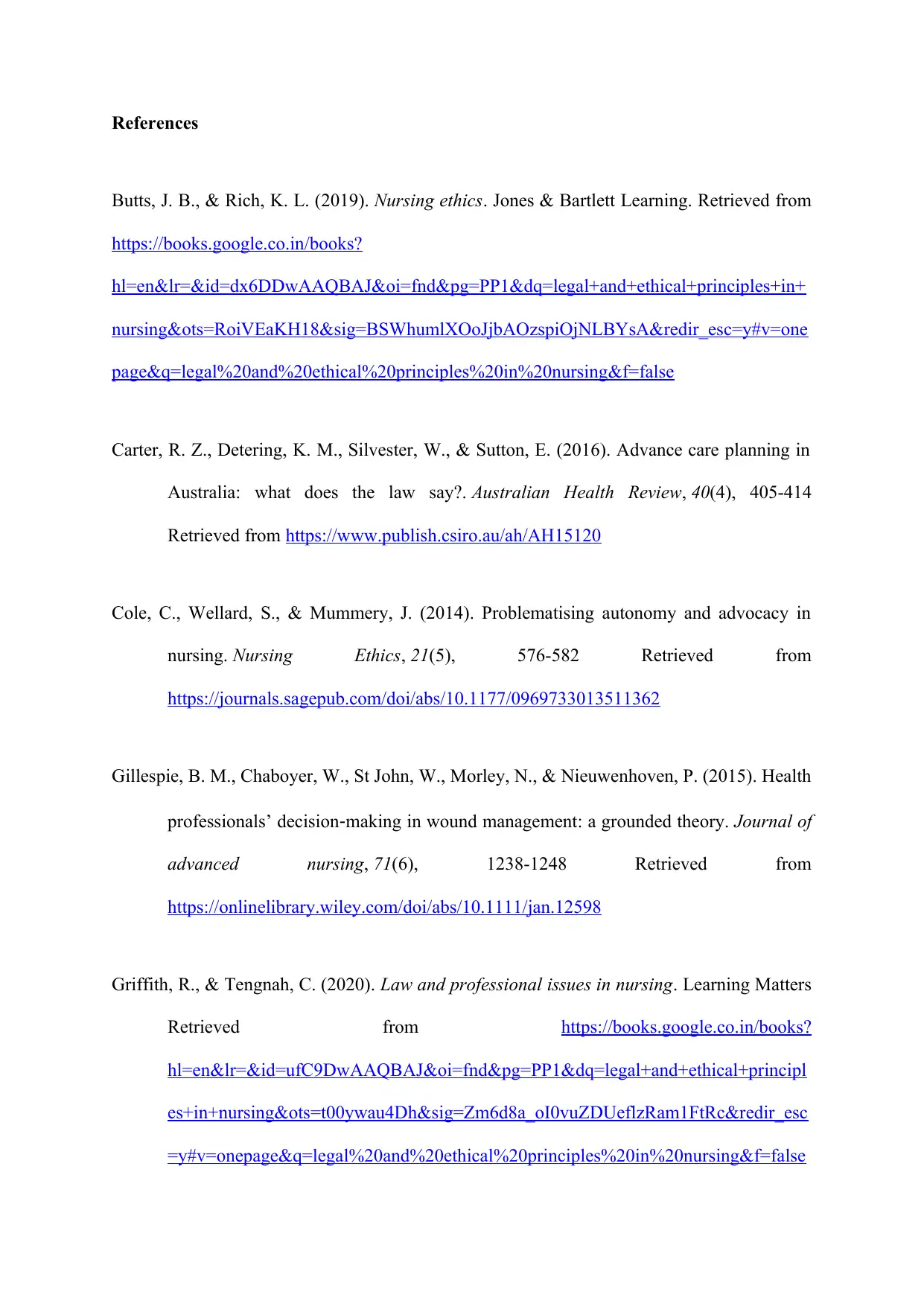
References
Butts, J. B., & Rich, K. L. (2019). Nursing ethics. Jones & Bartlett Learning. Retrieved from
https://books.google.co.in/books?
hl=en&lr=&id=dx6DDwAAQBAJ&oi=fnd&pg=PP1&dq=legal+and+ethical+principles+in+
nursing&ots=RoiVEaKH18&sig=BSWhumlXOoJjbAOzspiOjNLBYsA&redir_esc=y#v=one
page&q=legal%20and%20ethical%20principles%20in%20nursing&f=false
Carter, R. Z., Detering, K. M., Silvester, W., & Sutton, E. (2016). Advance care planning in
Australia: what does the law say?. Australian Health Review, 40(4), 405-414
Retrieved from https://www.publish.csiro.au/ah/AH15120
Cole, C., Wellard, S., & Mummery, J. (2014). Problematising autonomy and advocacy in
nursing. Nursing Ethics, 21(5), 576-582 Retrieved from
https://journals.sagepub.com/doi/abs/10.1177/0969733013511362
Gillespie, B. M., Chaboyer, W., St John, W., Morley, N., & Nieuwenhoven, P. (2015). Health
professionals’ decision‐making in wound management: a grounded theory. Journal of
advanced nursing, 71(6), 1238-1248 Retrieved from
https://onlinelibrary.wiley.com/doi/abs/10.1111/jan.12598
Griffith, R., & Tengnah, C. (2020). Law and professional issues in nursing. Learning Matters
Retrieved from https://books.google.co.in/books?
hl=en&lr=&id=ufC9DwAAQBAJ&oi=fnd&pg=PP1&dq=legal+and+ethical+principl
es+in+nursing&ots=t00ywau4Dh&sig=Zm6d8a_oI0vuZDUeflzRam1FtRc&redir_esc
=y#v=onepage&q=legal%20and%20ethical%20principles%20in%20nursing&f=false
Butts, J. B., & Rich, K. L. (2019). Nursing ethics. Jones & Bartlett Learning. Retrieved from
https://books.google.co.in/books?
hl=en&lr=&id=dx6DDwAAQBAJ&oi=fnd&pg=PP1&dq=legal+and+ethical+principles+in+
nursing&ots=RoiVEaKH18&sig=BSWhumlXOoJjbAOzspiOjNLBYsA&redir_esc=y#v=one
page&q=legal%20and%20ethical%20principles%20in%20nursing&f=false
Carter, R. Z., Detering, K. M., Silvester, W., & Sutton, E. (2016). Advance care planning in
Australia: what does the law say?. Australian Health Review, 40(4), 405-414
Retrieved from https://www.publish.csiro.au/ah/AH15120
Cole, C., Wellard, S., & Mummery, J. (2014). Problematising autonomy and advocacy in
nursing. Nursing Ethics, 21(5), 576-582 Retrieved from
https://journals.sagepub.com/doi/abs/10.1177/0969733013511362
Gillespie, B. M., Chaboyer, W., St John, W., Morley, N., & Nieuwenhoven, P. (2015). Health
professionals’ decision‐making in wound management: a grounded theory. Journal of
advanced nursing, 71(6), 1238-1248 Retrieved from
https://onlinelibrary.wiley.com/doi/abs/10.1111/jan.12598
Griffith, R., & Tengnah, C. (2020). Law and professional issues in nursing. Learning Matters
Retrieved from https://books.google.co.in/books?
hl=en&lr=&id=ufC9DwAAQBAJ&oi=fnd&pg=PP1&dq=legal+and+ethical+principl
es+in+nursing&ots=t00ywau4Dh&sig=Zm6d8a_oI0vuZDUeflzRam1FtRc&redir_esc
=y#v=onepage&q=legal%20and%20ethical%20principles%20in%20nursing&f=false
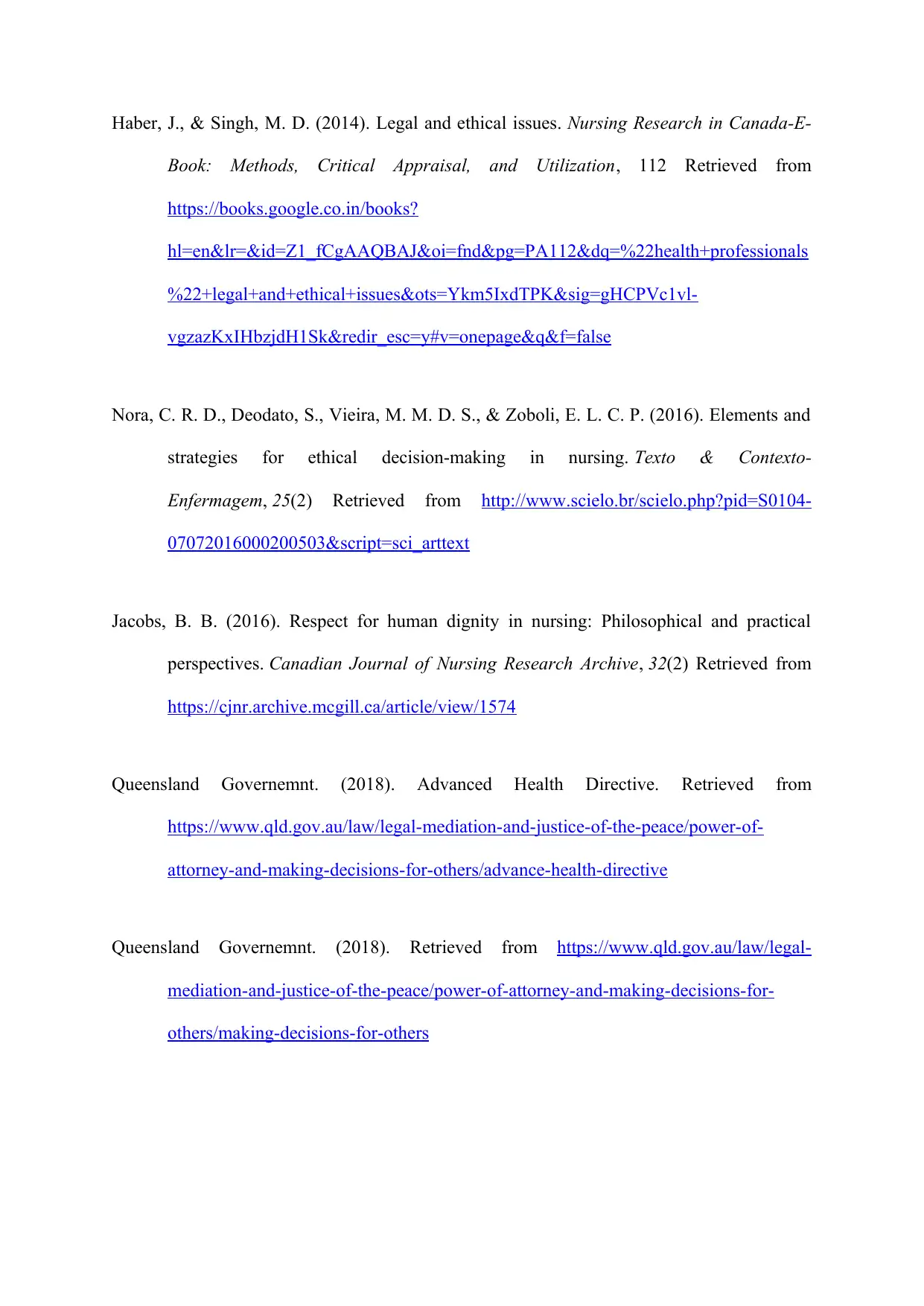
Haber, J., & Singh, M. D. (2014). Legal and ethical issues. Nursing Research in Canada-E-
Book: Methods, Critical Appraisal, and Utilization, 112 Retrieved from
https://books.google.co.in/books?
hl=en&lr=&id=Z1_fCgAAQBAJ&oi=fnd&pg=PA112&dq=%22health+professionals
%22+legal+and+ethical+issues&ots=Ykm5IxdTPK&sig=gHCPVc1vl-
vgzazKxIHbzjdH1Sk&redir_esc=y#v=onepage&q&f=false
Nora, C. R. D., Deodato, S., Vieira, M. M. D. S., & Zoboli, E. L. C. P. (2016). Elements and
strategies for ethical decision-making in nursing. Texto & Contexto-
Enfermagem, 25(2) Retrieved from http://www.scielo.br/scielo.php?pid=S0104-
07072016000200503&script=sci_arttext
Jacobs, B. B. (2016). Respect for human dignity in nursing: Philosophical and practical
perspectives. Canadian Journal of Nursing Research Archive, 32(2) Retrieved from
https://cjnr.archive.mcgill.ca/article/view/1574
Queensland Governemnt. (2018). Advanced Health Directive. Retrieved from
https://www.qld.gov.au/law/legal-mediation-and-justice-of-the-peace/power-of-
attorney-and-making-decisions-for-others/advance-health-directive
Queensland Governemnt. (2018). Retrieved from https://www.qld.gov.au/law/legal-
mediation-and-justice-of-the-peace/power-of-attorney-and-making-decisions-for-
others/making-decisions-for-others
Book: Methods, Critical Appraisal, and Utilization, 112 Retrieved from
https://books.google.co.in/books?
hl=en&lr=&id=Z1_fCgAAQBAJ&oi=fnd&pg=PA112&dq=%22health+professionals
%22+legal+and+ethical+issues&ots=Ykm5IxdTPK&sig=gHCPVc1vl-
vgzazKxIHbzjdH1Sk&redir_esc=y#v=onepage&q&f=false
Nora, C. R. D., Deodato, S., Vieira, M. M. D. S., & Zoboli, E. L. C. P. (2016). Elements and
strategies for ethical decision-making in nursing. Texto & Contexto-
Enfermagem, 25(2) Retrieved from http://www.scielo.br/scielo.php?pid=S0104-
07072016000200503&script=sci_arttext
Jacobs, B. B. (2016). Respect for human dignity in nursing: Philosophical and practical
perspectives. Canadian Journal of Nursing Research Archive, 32(2) Retrieved from
https://cjnr.archive.mcgill.ca/article/view/1574
Queensland Governemnt. (2018). Advanced Health Directive. Retrieved from
https://www.qld.gov.au/law/legal-mediation-and-justice-of-the-peace/power-of-
attorney-and-making-decisions-for-others/advance-health-directive
Queensland Governemnt. (2018). Retrieved from https://www.qld.gov.au/law/legal-
mediation-and-justice-of-the-peace/power-of-attorney-and-making-decisions-for-
others/making-decisions-for-others
⊘ This is a preview!⊘
Do you want full access?
Subscribe today to unlock all pages.

Trusted by 1+ million students worldwide
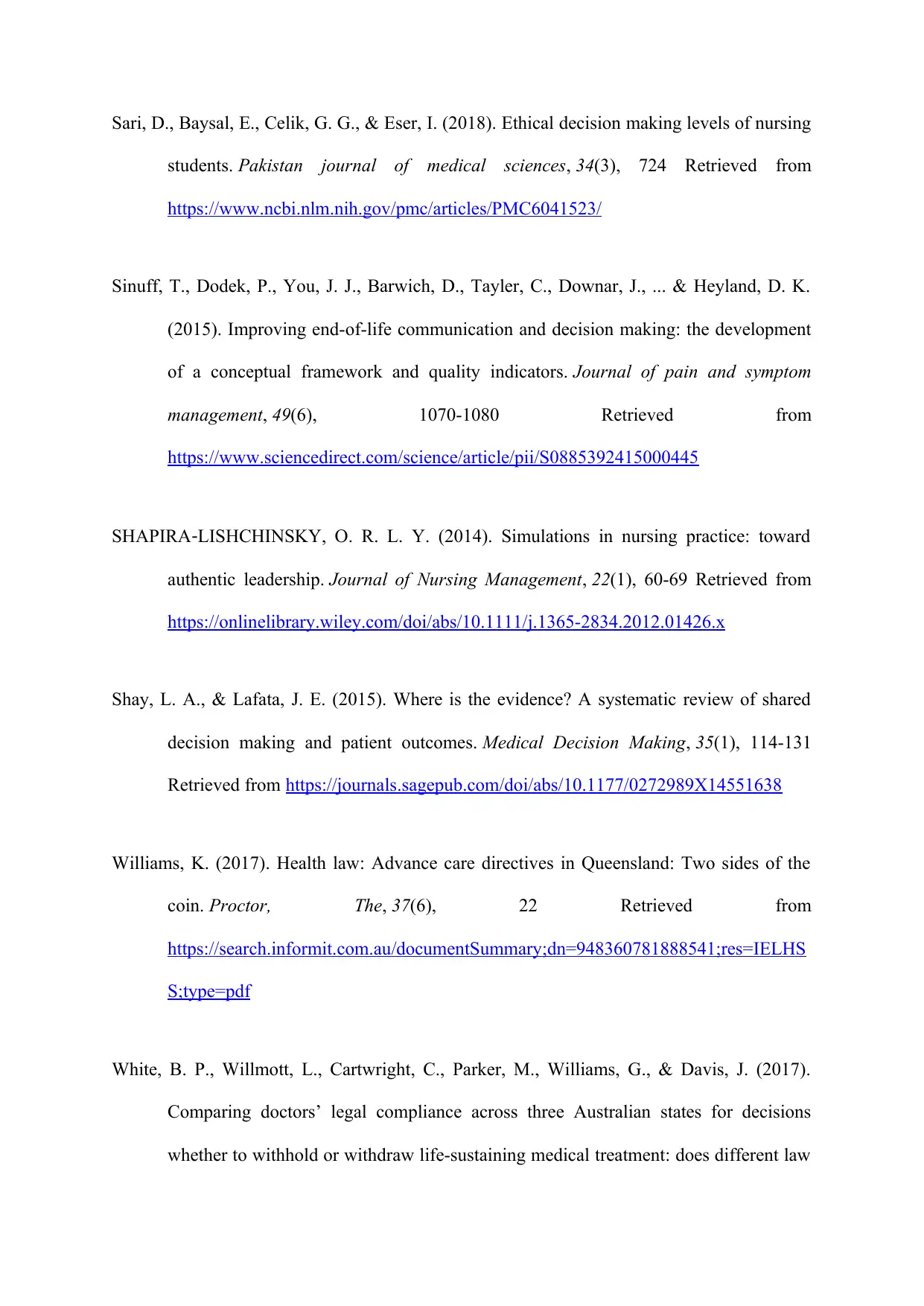
Sari, D., Baysal, E., Celik, G. G., & Eser, I. (2018). Ethical decision making levels of nursing
students. Pakistan journal of medical sciences, 34(3), 724 Retrieved from
https://www.ncbi.nlm.nih.gov/pmc/articles/PMC6041523/
Sinuff, T., Dodek, P., You, J. J., Barwich, D., Tayler, C., Downar, J., ... & Heyland, D. K.
(2015). Improving end-of-life communication and decision making: the development
of a conceptual framework and quality indicators. Journal of pain and symptom
management, 49(6), 1070-1080 Retrieved from
https://www.sciencedirect.com/science/article/pii/S0885392415000445
SHAPIRA‐LISHCHINSKY, O. R. L. Y. (2014). Simulations in nursing practice: toward
authentic leadership. Journal of Nursing Management, 22(1), 60-69 Retrieved from
https://onlinelibrary.wiley.com/doi/abs/10.1111/j.1365-2834.2012.01426.x
Shay, L. A., & Lafata, J. E. (2015). Where is the evidence? A systematic review of shared
decision making and patient outcomes. Medical Decision Making, 35(1), 114-131
Retrieved from https://journals.sagepub.com/doi/abs/10.1177/0272989X14551638
Williams, K. (2017). Health law: Advance care directives in Queensland: Two sides of the
coin. Proctor, The, 37(6), 22 Retrieved from
https://search.informit.com.au/documentSummary;dn=948360781888541;res=IELHS
S;type=pdf
White, B. P., Willmott, L., Cartwright, C., Parker, M., Williams, G., & Davis, J. (2017).
Comparing doctors’ legal compliance across three Australian states for decisions
whether to withhold or withdraw life-sustaining medical treatment: does different law
students. Pakistan journal of medical sciences, 34(3), 724 Retrieved from
https://www.ncbi.nlm.nih.gov/pmc/articles/PMC6041523/
Sinuff, T., Dodek, P., You, J. J., Barwich, D., Tayler, C., Downar, J., ... & Heyland, D. K.
(2015). Improving end-of-life communication and decision making: the development
of a conceptual framework and quality indicators. Journal of pain and symptom
management, 49(6), 1070-1080 Retrieved from
https://www.sciencedirect.com/science/article/pii/S0885392415000445
SHAPIRA‐LISHCHINSKY, O. R. L. Y. (2014). Simulations in nursing practice: toward
authentic leadership. Journal of Nursing Management, 22(1), 60-69 Retrieved from
https://onlinelibrary.wiley.com/doi/abs/10.1111/j.1365-2834.2012.01426.x
Shay, L. A., & Lafata, J. E. (2015). Where is the evidence? A systematic review of shared
decision making and patient outcomes. Medical Decision Making, 35(1), 114-131
Retrieved from https://journals.sagepub.com/doi/abs/10.1177/0272989X14551638
Williams, K. (2017). Health law: Advance care directives in Queensland: Two sides of the
coin. Proctor, The, 37(6), 22 Retrieved from
https://search.informit.com.au/documentSummary;dn=948360781888541;res=IELHS
S;type=pdf
White, B. P., Willmott, L., Cartwright, C., Parker, M., Williams, G., & Davis, J. (2017).
Comparing doctors’ legal compliance across three Australian states for decisions
whether to withhold or withdraw life-sustaining medical treatment: does different law
Paraphrase This Document
Need a fresh take? Get an instant paraphrase of this document with our AI Paraphraser

lead to different decisions?. BMC palliative care, 16(1), 63 Retrieved from
https://link.springer.com/article/10.1186/s12904-017-0249-1
https://link.springer.com/article/10.1186/s12904-017-0249-1
1 out of 11
Related Documents
Your All-in-One AI-Powered Toolkit for Academic Success.
+13062052269
info@desklib.com
Available 24*7 on WhatsApp / Email
![[object Object]](/_next/static/media/star-bottom.7253800d.svg)
Unlock your academic potential
Copyright © 2020–2025 A2Z Services. All Rights Reserved. Developed and managed by ZUCOL.





